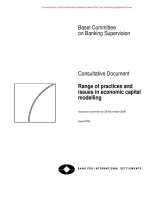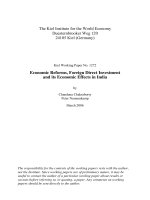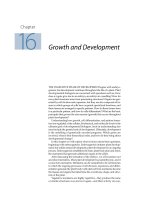JOBS GROWTH AND LONG-TERM PROSPERITY ECONOMIC ACTION PLAN 2012 pdf
Bạn đang xem bản rút gọn của tài liệu. Xem và tải ngay bản đầy đủ của tài liệu tại đây (4.72 MB, 498 trang )
ECONOMIC ACTION PLAN 2012
Tabled in the House of Commons
By the Honourable
James M. Flaherty, P.C., M.P.
Minister of Finance
March 29, 2012
JOBS
GROWTH
AND
LONG-TERM
PROSPERITY
Budget2012_BW_TitlePage_EN.indd 1 12-03-26 2:50 PM
©Her Majesty the Queen in Right of Canada (2012)
All rights reserved
All requests for permission to reproduce this document
or any part thereof shall be addressed to
Public Works and Government Services Canada.
Available through your local bookseller or by mail from
Publishing and Depository Services
Public Works and Government Services Canada
Ottawa, Ontario K1A 0S5
Telephone: 613-941-5995
Orders only: 1-800-635-7943 (Canada and U.S.A.)
Fax: 613-954-5779 or 1-800-565-7757 (Canada and U.S.A.)
Internet: http//publications.gc.ca
Cat. No.: F1-23/3-2012E
ISBN: 978-0-660-20189-4
This document is also available n the Internet at www.fin.gc.ca
Cette publication est aussi disponible en français.
3
Chapter 1 – Introduction 11
Chapter 2 –Economic Developments and Prospects
23
Highlights 25
Introduction 26
Global Economic Developments and Outlook 26
Canada’s Recent Economic Performance 32
Financial Market Developments 38
Commodity Prices 40
Canadian Economic Outlook—Private Sector Forecasts 41
Risk Assessment and Planning Assumptions 43
Chapter 3 – Supporting Jobs and Growth
3.0 – Supporting Jobs and Growth 47
Introduction 49
3.1 – Supporting Entrepreneurs, Innovators
and World-Class Research
51
Highlights 53
Creating Value-Added Jobs Through Innovation 53
Support for Research, Education and Training 54
Creating Value-Added Jobs Through Innovation 55
Helping High-Growth Firms Access Risk Capital 60
Increasing Direct Support for Business Innovation 61
Doubling the Industrial Research Assistance Program 61
Supporting Innovative Businesses in Western Canada 62
Supporting Private and Public Sector Research Collaboration 63
Integrating High-Quality Researchers Into the Labour Market 63
Strengthening Knowledge Transfer and Commercialization 65
Forestry Innovation and Market Development Support 66
Supporting Innovation Through Procurement
66
Re
focusing the National Research Council 68
4
Scientific Research and Experimental Development Tax Incentive Program 68
Simplifying the Tax Credit Base 69
Increasing Cost-Effectiveness 69
Enhancing Predictability 70
Contingency Fees 71
Support for Research, Education and Training 72
Supporting Advanced Research 72
Promoting Post-Secondary and Private Sector Research Collaborations 73
Investing in Genomics Research 74
Investing in Mental Health Research 75
Promoting Cost-Effective Health Care 76
Advancing Knowledge and Treatment of Spinal Cord Injury 76
Diversifying Canada’s Medical Isotope Supply 76
Supporting Leading-Edge Researchers 77
Investing in Leading-Edge Research Infrastructure 77
Canada Foundation for Innovation 77
Supporting Canada’s Ultra-High Speed Research Network 79
The Canadian High Arctic Research Station 79
Extending Canada’s Participation in the International
Space Station Mission 79
Revitalizing Natural Resources Canada’s Satellite Station Facilities 80
Supporting Atomic Energy of Canada Limited 80
International Education Strategy 81
3.2 – Improving Conditions for Business Investment 83
Highlights 85
Responsible Resource Development 85
Investing in Our Natural Resources 85
Ex
panding Trade and Opening New Markets for Canadian Businesses 85
Keeping Taxes Low for Job-Creating Businesses 86
Improving Economic Conditions for Farmers and Fishermen 86
Strengthening Business Competitiveness 86
Further Developing Canada’s Financial Sector Advantage 86
Improving Conditions for Business Investment 87
Responsible Resource Development 88
Modernizing the Regulatory System for Project Reviews 89
Major Projects Management Office Initiative
94
Consultation Under the Canadian Environmental Assessment Act 97
Supporting Responsible Energy Development 97
5
Strengthening Pipeline Safety 99
The Northern Pipeline Agency 99
Amending Mining Regulations 99
Investing in Our Natural Resources 100
Supporting Junior Mineral Exploration 100
Supporting Offshore Oil & Gas Exploration 101
Assessing Diamonds in the North 101
Expanding Trade and Opening New Markets for Canadian Businesses 101
Canada’s Leadership on Trade 102
Canada’s Trade Plan for Jobs and Growth 102
Canada-U. S. Border and Regulatory Action Plans 103
Deeper Canada-China Ties 103
Canada-EU Trade Agreement 104
Canada-India Trade Agreement 104
Trans-Pacific Partnership 104
Active and Ongoing Engagement in the Asia-Pacific Region 104
Canada in the Americas 105
Deeper Canada-Africa Ties 105
Deepening Canada’s Trade and Investment Ties in Priority Markets: A Refreshed
Global Commerce Strategy 106
Trade Measures to Support the Energy Industry 107
Export Development Canada 107
Streamlining Canada’s Trade Remedy System 108
Foreign Trade Zone Programming 108
Incr
easing Travellers’ Exemptions 108
Tax Relief for Foreign-Based Rental Vehicles 109
International Taxation 110
Tax Treaties and Tax Information Exchange Agreements 111
Fostering Sustainable Global Growth 112
Providing Stewardship in the G-20 112
Strengthening the Legitimacy and Effectiveness
of the International Monetary Fund 112
Increasing the Impact of Canadian Development Assistance 113
Refocusing Canada’s Tariff Regime for Developing Countries 114
Keeping Taxes Low for Job-Creating Businesses 114
A Competitive Business Tax System 114
Enhancing the Neutrality of the Tax System 118
Phasing Out the Atlantic Investment Tax Credit—Oil & Gas and Mining 118
Phasing Out the Corporate Mineral Exploration
and Development Tax Credit 119
6
Improving Economic Conditions for Farmers and Fishermen 119
Strengthening Agricultural Institutions 119
Supporting Canada’s Fisheries 120
Strengthening Business Competitiveness 120
Fostering Foreign Investment 120
Reducing Red Tape 121
Reducing the Tax Compliance Burden for Businesses 123
A Doubling of the Goods and Services Tax/Harmonized Sales
Tax (GST/HST) Streamlined Accounting Thresholds 124
Simplified Administration for Partnerships 124
Improvements to the Rules for Paying Eligible Dividends 124
Administrative Improvements That Enhance the Predictability
of the Scientific Research and Experimental Development (SR&ED)
Tax Incentive Program 124
Written Responses to Business Enquiries 125
Expansion of Web Forms for Information Returns 125
Enhancements to the CRA’s Secure My Business Account Portal 125
An Improved Business Section on the CRA’s Website 125
Graduated Penalties for Late Filing 126
Continued CRA Progress on Tax Fairness 126
Taxation of Corporate Groups 126
Further Developing Canada’s Financial Sector Advantage 127
Fostering Stable, Competitive, Fair and Efficient Capital Markets 127
Preserving the Stability and Strength of Canada’s Financial Sector 128
Enhancing the Governance and Oversight Framework for Canada Mortgage
and Housing Corporation 128
Improving Access to Capital for Canadian Financial Institutions
129
Cl
arifying Federal Jurisdiction Over Banking 130
Clarifying the Separation of Insurance and Banking 130
Continuing to Fight Counterfeit Bank Notes 131
3.3 – Investing in Training, Infrastructure
and Opportunity
133
Highlights 135
Supporting Job Creation, Small Business and Skills Training 135
Improving the Employment Insurance Program 135
Expanding Opportunities for Aboriginal Peoples to Fully Participate
in the Economy 136
Building a Fast and Flexible Economic Immigration System 136
Strengthening Canada’s Public Infrastructure 137
7
Supporting Job Creation 138
Supporting Job Creation, Small Business and Skills Training 139
Extending the Hiring Credit for Small Business 139
Enhancing the Youth Employment Strategy 140
ThirdQuarter Project 141
Improving Labour Market Opportunities for Canadians With Disabilities 142
Women on Corporate Boards 143
Promoting Widespread Opportunities From Federal Shipbuilding 144
Improving the Employment Insurance Program 145
Stable and Predictable EI Premium Rates 145
Connecting Canadians With Available Jobs 146
Removing Disincentives to Work 147
Expanding Opportunities for Aboriginal Peoples to Fully Participate
in the Economy 148
Investments to Improve First Nations Education 149
Helping First Nations on Reserve Access the Labour Force 150
Supporting First Nations Fishing Enterprises 150
Urban Aboriginal Strategy 151
Building a Fast and Flexible Economic Immigration System 151
Strengthening Canada’s Immigration System 151
Temporary Foreign Worker Program 152
Pan-Canadian Framework for the Assessment and Recognition of Foreign
Qualifications 153
Federal Skilled Worker Fee Refund 154
Strengthening Canada’s Public Infrastructure 155
Sup
porting Provincial, Territorial and Municipal Infrastructure 156
Territorial Borrowing Limit 157
Making Important Investments in Strategic Public Infrastructure 157
Maintaining Safe and Reliable Passenger Rail Services 157
Strengthening Canada’s Port System 158
Renewing the Canadian Coast Guard Fleet 158
Maintaining and Improving Federal Infrastructure 159
Investing in Border Infrastructure 159
Building a New Bridge over the St. Lawrence 159
8
3.4 – Supporting Families and Communities 163
Highlights 165
Protecting the Health and Safety of Canadians 165
Investing in Communities 165
Supporting Families 166
Protecting Canada’s Natural Environment and Wildlife 166
Supporting Families and Communities 167
Protecting the Health and Safety of Canadians 167
Health-Related Tax Measures 167
Strengthening Food Safety 168
Fair Compensation for Employers of Canada’s Reservists 169
Enhancing the Victims Fund 169
Canadian Nuclear Safety Commission 170
Investing in Communities 171
Improving Economic Potential on First Nations Lands 171
Investments to Improve First Nations Water Infrastructure 172
Addressing Family Violence on Reserve 172
Aboriginal Mental Health Programs 173
Supporting Effective Government-Community Partnerships 173
Investments in Arts and Culture 174
Canada Council for the Arts 174
Commemorations for the Bicentennial of the War of 1812 175
Official Languages 175
Encouraging Participation and Healthy Communities
175
Str
engthening Health Care in Rural and Remote Communities 176
Strengthening Access to Broadband in Rural Areas 177
Support to Provinces and Territories for the Floods of 2011 177
Supporting Families 178
Keeping Taxes Low for Families and Individuals 178
Wage Earner Protection Program 179
Protecting Long-Term Disability Plans 180
Review of the Registered Disability Savings Plan 180
Establishing Plans and Legal Representation 182
Protecting Canada’s Natural Environment and Wildlife 183
Protecting Species at Risk
183
Protecting Water and Wildlife Resources 183
Port Hope Area Initiative 184
Rouge Valley National Near-Urban Park 185
Expanding Tax Support for Clean Energy Generation 185
9
Chapter 4 – Sustainable Social Programs
and a Secure Retirement
187
Highlights 189
Sustainable Management of Public Finances 190
Putting Transfers on a Long-Term, Sustainable Growth Track 190
A Strong Retirement Income System for Canadians 192
Old Age Security Age of Eligibility 197
Option to Defer the OAS Pension 198
Proactive Enrolment for OAS and GIS Benefits 199
Canada Pension Plan 199
Federally Regulated Pension Plans 202
Improving Tax Fairness and Integrity 203
Enhancing Transparency and Accountability for Charities 204
Chapter 5 – Responsible Management
to Return to Balanced Budgets
207
Highlights 209
Responsible Management of Public Finances 210
The Plan to Return to Balance 210
Reductions in Departmental Spending 211
Refocusing Government and Programs 217
Making It Easier for Canadians and Businesses
to Deal With Their Government 219
Modernizing and Reducing the Back Office 220
Workforce Impact 221
Responsible Expenditure Management 222
Updating Defence Capital Funding 223
Modernizing the Government’s Information Technology:
Shared Services Canada 223
Administrative Services Review—Moving Forward 224
Parliamentary Expenses 224
Public Sector Compensation 224
Pensions of Public Servants and Parliamentarians 225
Corporate Asset Management Review 226
Greater Use
of Telepresence Technology 226
Next Steps 226
10
Chapter 6 – Fiscal Outlook 227
Highlights 229
Introduction 230
Fiscal Planning Framework 233
Approach to Budget Planning 233
Fiscal Outlook Before the Measures Announced in Budget 2012 233
Fiscal Impact of Measures Announced in Budget 2012 236
Summary of Statement of Transactions 238
Outlook for Budgetary Revenues 239
Outlook for Program Expenses 243
Financial Source/Requirement 247
Risks to the Fiscal Projections 250
Sensitivity of the Budgetary Balance to Economic Shocks 250
Annex 1 –Responsible Spending 255
Annex 2 – The Stimulus Phase of Canada’s Economic
Action Plan: A Final Report to Canadians
285
Highlights 287
The Stimulus Phase of Canada’s Economic Action Plan 288
Results Achieved 296
Job Impact of the Stimulus Phase of the Economic Action Plan 350
Conclusion 356
Annex 3 – Debt Management Strategy for 2012–13 357
Annex 4 – Tax Measures: Supplementary Information,
Notices of Ways and Means Motions and Draft
Amendments to Various GST/HST Regulations
373
Chapter 1
Introducon
Chapter 1
Introducon
Introduction
13
We see Canada for what it is and what it can be—a great, good
nation, on top of the world, the True North strong and free. Our
government has been inspired by this vision from the beginning.
Today we step forward boldly, to realize it fully—hope for our
children and grandchildren; opportunity for all Canadians; a
prosperous future for our beloved country.
— The Honourable Jim Flaherty,
Minister of Finance
Chapter 1
14
Canada is emerging from the global economic recession. The economy’s
strengths provide an opportunity for the Government to take significant
actions today that will fuel the next wave of job creation and position
Canada for a secure and prosperous future. Economic Action Plan 2012
sets out a comprehensive agenda to bolster Canada’s fundamental strengths
and address the important challenges confronting the economy over the
long term.
Canada faces a fast-changing global environment, with increasing
competition from emerging market countries and a global economy that
remains fragile and uncertain. For this reason, the Government remains
focused on an agenda that will deliver high-quality jobs, economic growth
and sound public finances. Economic Action Plan 2012 will help further
unleash the potential of Canadian businesses and entrepreneurs to innovate
and thrive in the modern economy to the benefit of all Canadians for
generations to come.
Since 2006, the Government has supported the security and prosperity of
Canadians and promoted business and investment to create jobs. When the
global financial and economic crisis struck, these underlying strengths helped
Canada to avoid a deep and long-lasting recession. The Government’s sound
fiscal position prior to the crisis provided the flexibility to launch the
stimulus phase of Canada’s Economic Action Plan, which was timely,
targeted and temporary in order to have maximum impact. This plan was one
of the strongest responses to the global recession among the Group of Seven
(G-7) countries.
Economic output in Canada is now well above pre-recession levels, and
more than 610,000 jobs have been created since the recovery began in
July 2009, the best performance in the G-7.
Canadian authorities have a strong track record in managing past
economic and financial crises and delivering economic growth.
— Standard & Poor’s, October 25, 2011
Introduction
15
Canada cannot rest on this record of success. There are many challenges and
uncertainties still confronting the economy. The recovery is not complete
and too many Canadians are still looking for work. The global economy
remains fragile and any potential setbacks would have an impact on Canada.
Canadian businesses face ever-increasing competition from emerging
fast-growth countries. Our aging population will put pressure on public
finances and social programs.
Economic Action Plan 2012 takes important steps to address these structural
challenges and ensure the sustainability of public finances and social
programs for future generations. International experience shows the
importance of taking action now, rather than delaying. Economic Action
Plan 2012 focuses on the drivers of growth and job creation—innovation,
investment, education, skills and communities. Underpinning these actions
is the ongoing commitment to keeping taxes low, which is central to the
Government’s long-term economic plan.
SUPPORTING ENTREPRENEURS, INNOVATORS
AND WORLD-CLASS RESEARCH
The global economy is increasingly competitive. The pace of technological
change is creating new opportunities while making older business practices
obsolete. To succeed and thrive in this environment, Canadian businesses
need to innovate and create high-quality jobs. The Government has a strong
record of support for research and development. But Canada can and must
do better to promote innovation. The Government launched an Expert
Panel in 2010 to review federal support for research and development.
Informed by the advice of the Panel, the Government is taking action toward
a new approach to supporting innovation in Canada.
Economic Action Plan 2012 will:
• Increase funding for research and development by small and medium-
sized companies.
• Promote linkages and collaborations, including funding internships and
connecting private sector innovators to procurement opportunities in
the federal government.
• Refocus the National Research Council on research that helps Canadian
businesses develop innovative products and services.
• Enhance access to venture capital financing by high-growth companies
so that they have the capital they need to create jobs and grow.
Chapter 1
16
• Streamline and improve the Scientific Research and Experimental
Development tax incentive program, including shifting from indirect
tax incentives to more direct support for innovative private
sector businesses.
• Support research, education and training with new funding for
universities, granting councils and leading research institutions,
such as Genome Canada.
RESPONSIBLE RESOURCE DEVELOPMENT
Canada’s resource sector is an asset that will increasingly contribute to the
prosperity of all Canadians. Some $500 billion is expected to be invested in
over 500 major economic projects across Canada over the next 10 years,
driven in part by demand from emerging economies. Today, Canadian
businesses in the resource sector must navigate a maze of overlapping and
complex regulatory requirements and red tape. This leads to delays in
investment and job creation that do not contribute to better
environmental outcomes.
An efficient regulatory system provides effective protection of the interests
of Canadians while minimizing the burden on businesses. It is a vital
component of an attractive climate for investment and jobs. Since 2006, the
Government has worked to streamline and improve regulatory processes.
However, more needs to be done.
The Government is committed to reforming the regulatory system in the
resource sector so that reviews are conducted in a timely and transparent
manner, while safeguarding the environment. This will increase business
confidence and enhance investment and job creation. The Government
will continue to support responsible energy development.
Economic Action Plan 2012 will:
• Commit to bringing forward legislation to achieve the goal of
“one project, one review” in a clearly defined time period.
• Make new investments to improve regulatory reviews, streamline the
review process for major economic projects, support consultation with
Aboriginal peoples, and strengthen pipeline and marine safety.
• Continue to support the Major Projects Management Office initiative,
which has succeeded in shortening and streamlining reviews and
improving accountability.
• Ensure the safety and security of Canadians and the environment as
energy resources are developed.
Introduction
17
EXPANDING TRADE AND OPENING NEW MARKETS
FOR
CANADIAN BUSINESSES
Free and open trade has long been a powerful engine for Canada’s economy.
Canadian businesses need access to key export markets in order to take
advantage of new opportunities. Over the past six years, Canada has
concluded free trade agreements with nine countries as well as foreign
investment promotion and protection agreements with ten countries.
Since 2009, Canada has eliminated all tariffs on imported machinery and
equipment and manufacturing inputs to make Canada a tariff-free zone
for industrial manufacturers, the first in the G-20 to do so.
Economic Action Plan 2012 will:
• Intensify Canada’s pursuit of new and deeper trading relationships,
particularly with large, dynamic and fast-growing economies.
• Implement the Action Plan on Perimeter Security and Economic
Competitiveness and the Action Plan on Regulatory Cooperation, which
will facilitate trade and investment flows with the United States.
• Provide support to Canadian exporters by extending the provision
of domestic financing by Export Development Canada.
INVESTING IN TRAINING, INFRASTRUCTURE
AND OPPORTUNITY
Canada’s well-trained and highly educated workforce represents one of our
key advantages in competing and succeeding in the global economy. Too
often, barriers or disincentives discourage workforce participation. Better
utilizing Canada’s workforce and making Canada’s labour market more
adaptable will help ensure Canada’s long-term economic growth.
Economic Action Plan 2012 will:
• Make investments to assist more young people in gaining tangible skills
and experience.
• Extend and expand the ThirdQuarter project to better connect workers
over the age of 50 to potential employers.
• Invest to enable more Canadians with disabilities to obtain work
experience with small and medium-sized businesses.
Chapter 1
18
• Introduce a number of targeted, common-sense changes to Employment
Insurance (EI) to make it a more efficient program that promotes job
creation, removes disincentives to work, supports unemployed Canadians
and quickly connects people to jobs.
• Support small and medium-sized businesses and their workers by making
EI premiums more stable and predictable, with annual increases limited
to five cents.
• Extend the Hiring Credit for Small Business for one year to help
small businesses to defray the costs of hiring new workers.
• Promote job creation by renewing the Canadian Coast Guard Fleet;
supporting the involvement of small and medium-sized enterprises in the
National Shipbuilding Procurement Strategy; investing in transportation
infrastructure, including railways and ports; and providing funding for
community public infrastructure facilities.
EXPANDING OPPORTUNITIES FOR ABORIGINAL PEOPLES
TO FULLY PARTICIPATE IN THE ECONOMY
The Government recognizes the contribution that Aboriginal peoples can
make to the labour force as the youngest and fastest-growing segment of
the nation’s population. Equipping First Nations people with the skills and
opportunities they need to fully participate in the economy is a priority both
for this Government and for First Nations people.
Economic Action Plan 2012 will:
• Invest in First Nations education on reserve, including early literacy
programming and other supports and services to First Nations schools
and students.
• Build and renovate schools on reserve, providing First Nations youth
with better learning environments.
• Commit to introduce a First Nation Education Act and work with willing
partners to establish the structures and standards needed to support
strong and accountable education systems on reserve.
• Improve the incentives of the on-reserve Income Assistance Program
while encouraging those who can work to access training that will
improve their prospects for employment.
• Renew the Urban Aboriginal Strategy to improve economic
opportunities for Aboriginal peoples living in urban centres.
Introduction
19
BUILDING A FAST AND FLEXIBLE
E
CONOMIC IMMIGRATION SYSTEM
Since 2006, the Government has pursued much-needed reforms to focus
Canada’s immigration system on fuelling economic prosperity for Canada.
The Government has placed top priority on attracting immigrants who have
the skills and experience our economy needs. The Government is committed
to making our immigration system truly fast and flexible in a way that will
sustain Canada’s economic growth.
Economic Action Plan 2012 will:
• Realign the Temporary Foreign Worker Program to better meet labour
market demands.
• Support further improvements to foreign credential recognition
and identify the next set of target occupations beyond 2012.
• Move to an increasingly fast and flexible immigration system where
priority focus is on meeting Canada’s labour market needs.
• Return applications and fees to certain federal skilled worker
applicants who have been waiting for processing to be completed.
SUSTAINABLE SOCIAL PROGRAMS AND
A SECURE RETIREMENT
In order to ensure the sustainability of our social programs and fiscal
position for generations to come, steps are required to prepare today for the
demographic pressures that the Canadian economy will face over the longer
term. Canadians are living longer and healthier lives. Many older workers
wish to work longer and increase their retirement income.
The Government has already taken steps to ensure sound public finances
by setting a future growth path for transfers to the provinces and territories.
The growth path will provide predictable, fair and sustainable funding in
support of the provision of health care, education and other services for
all Canadians.
Chapter 1
20
Economic Action Plan 2012 will:
• Gradually increase the age of eligibility for Old Age Security (OAS)
and Guaranteed Income Supplement benefits from 65 to 67. This change
will start in April 2023, with full implementation by January 2029,
and will not affect anyone who is 54 years of age or older as of
March 31, 2012.
• Improve flexibility and choice by allowing Canadians the option of
deferring take-up of their OAS benefits to a later time and receiving
higher annual benefits.
• Ensure that pension plans for public servants and Parliamentarians are
sustainable, fair and financially responsible.
• Support the retirement income system with Pooled Registered Pension
Plans that provide an accessible, large-scale and low-cost pension option
to employers, employees and the self-employed.
RESPONSIBLE EXPENDITURE MANAGEMENT
Canadians expect value for money from their government. Over the past
year, the Government conducted a comprehensive review of approximately
$75 billion of direct program spending by federal departments and agencies.
The review identified a number of opportunities to enhance the efficiency
and effectiveness of government operations, programs and services that will
result in cost savings for the Canadian taxpayer. This will support the
Government’s commitment to return to balanced budgets over the medium
term. The Government is on track to meet its commitment to balance the
budget without cutting transfers to Canadians or to provinces.
Fiscal policy is appropriately shifting toward consolidation in the
aftermath of the effective stimulus program. The federal
government is leading the initial fiscal effort, as spending is
gradually being brought to pre-crisis levels as a share of GDP.
— International Monetary Fund
November 23, 2011
Introduction
21
Reflecting Canada’s strong economic and fiscal fundamentals, Canada will
undertake expenditure reductions that are modest compared to those being
pursued by many countries around the world. These targeted reductions
clearly contrast with the Program Review undertaken in Canada in the
mid-1990s, when transfers for health care, education and social spending
were cut.
Economic Action Plan 2012 will:
• Achieve ongoing savings of $5.2 billion, 6.9 per cent of the review base
of approximately $75 billion. This represents less than 2.0 per cent
of expected federal program spending in 2016–17, or about 0.2 per cent
of Canada’s gross domestic product (GDP) in that same year.
THE PLAN TO RETURN TO BALANCED BUDGETS
Canadians know the importance of living within their means and expect the
Government to do the same. That is why the Government is committed to
managing public finances in a sustainable and responsible manner. The
Government’s responsible financial management put Canada in a position of
strength when it came time to combat the global recession. From 2006 to
2008, the Government paid down over $37 billion in debt, significantly
contributing to Canada’s low net debt position. This enabled the Government
to quickly implement the stimulus phase of Canada’s Economic Action Plan
without leaving the country in a vulnerable fiscal position, like many
European countries.
Balancing the budget and reducing debt cuts interest costs, helps to keep
interest rates low and instills confidence in Canada’s economy, allowing
families and businesses to plan for the future. It will also ensure the
sustainability of Canada’s social programs for future generations.
Chapter 1
22
The Government is on track to return to balanced
budgets over the medium term
Chart 1.1
Budgetary Balance After Economic Action Plan 2012 Measures
Source: Department of Finance.
CONCLUSION
Economic Action Plan 2012 is a plan for jobs, growth and long-term
prosperity. By making choices now, the Government is taking the necessary
steps to reinforce the fundamental strength and promise of the Canadian
economy in order to sustain economic growth, create the high-quality jobs of
tomorrow, preserve social programs and sound public finances, and deliver
continued prosperity for generations to come.
Chapter 1
Introducon
Chapter 2
Economic Developments
and Prospects
Economic Developments and Prospects
25
HIGHLIGHTS
The global economic recovery remains fragile. The European
sovereign debt and banking crisis continues to weigh on
global growth.
The Canadian economy has remained resilient despite external
weakness, reflecting sustained growth in the domestic economy.
Canada has had the strongest economic growth over the recession
and recovery among Group of Seven (G-7) countries. This reflects
our solid economic fundamentals and the timely support of the
stimulus phase of Canada’s Economic Action Plan.
610,000 more Canadians are working now than in July 2009, the
strongest job growth among G-7 countries over the recovery.
This continues the strong performance that has resulted in over
1.1 million new jobs created since the beginning of 2006.
However, the fragile global economic environment will continue
to be reflected in modest growth in Canada over the near term.
The Department of Finance conducted a survey of private sector
economists in early March 2012. On March 5, economists met with
the Minister of Finance to discuss the economic forecast as well as
the risks associated with the outlook.
Private sector economists expect real gross domestic product
(GDP) growth of 2.1 per cent in 2012 and 2.4 per cent in 2013,
broadly unchanged from the November 2011 Update of Economic
and Fiscal Projections.
Economists also expect the level of nominal GDP—the broadest
single measure of the tax base—to be above the level anticipated
over the forecast period at the time of the November Update.
Private sector economists agreed that near-term risks to the outlook
have slightly moderated since the November Update, but continue
to see global economic uncertainty as the key downside risk—
in particular the potential for wider contagion of the sovereign
debt and banking crisis in Europe.
To reflect the downside risks surrounding the global economic
outlook, the Government is adjusting the private sector forecast
for nominal GDP downward by $20 billion in each year of the
2012–2016 forecast period.
Notes: This chapter incorporates data available up to and including March 23, 2012, unless otherwise
indicated. All rates are reported at annual rates unless otherwise noted.









